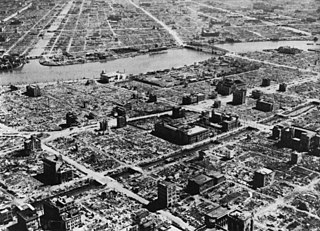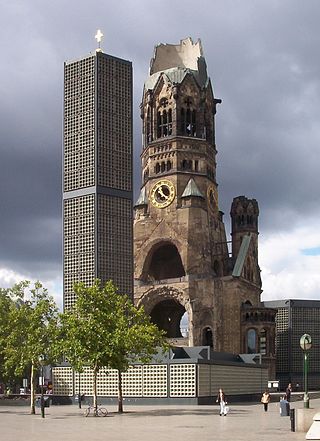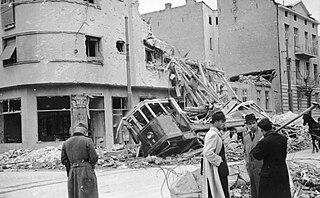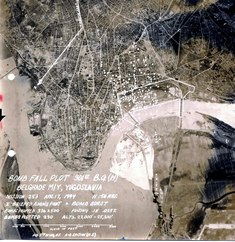
Strategic bombing is a systematically organized and executed military attack from the air which can utilize strategic bombers, long- or medium-range missiles, or nuclear-armed fighter-bomber aircraft to attack targets deemed vital to the enemy's war-making capability. It is a military strategy used in total war with the goal of defeating the enemy by destroying its morale, its economic ability to produce and transport materiel to the theatres of military operations, or both. The term terror bombing is used to describe the strategic bombing of civilian targets without military value, in the hope of damaging an enemy's morale.

The Fifteenth Air Force is a numbered air force of the United States Air Force's Air Combat Command (ACC). It is headquartered at Shaw Air Force Base. It was reactivated on 20 August 2020, merging the previous units of the Ninth Air Force and Twelfth Air Force into a new numbered air force responsible for generating and presenting Air Combat Command's conventional forces.

World War II (1939–1945) involved sustained strategic bombing of railways, harbours, cities, workers' and civilian housing, and industrial districts in enemy territory. Strategic bombing as a military strategy is distinct both from close air support of ground forces and from tactical air power. During World War II, many military strategists of air power believed that air forces could win major victories by attacking industrial and political infrastructure, rather than purely military targets. Strategic bombing often involved bombing areas inhabited by civilians, and some campaigns were deliberately designed to target civilian populations in order to terrorize them and disrupt their usual activities. International law at the outset of World War II did not specifically forbid the aerial bombardment of cities – despite the prior occurrence of such bombing during World War I (1914–1918), the Spanish Civil War (1936–1939), and the Second Sino-Japanese War (1937–1945).

Berlin, the capital of Germany, was subject to 363 air raids during the Second World War. It was bombed by the RAF Bomber Command between 1940 and 1945, the United States Army Air Forces' Eighth Air Force between 1943 and 1945, and the French Air Force in 1940 and between 1944 and 1945 as part of the Allied campaign of strategic bombing of Germany. It was also attacked by aircraft of the Red Air Force in 1941 and particularly in 1945, as Soviet forces closed on the city. British bombers dropped 45,517 tons of bombs, while American aircraft dropped 22,090.3 tons. As the bombings continued, more and more people fled the city. By May 1945, 1.7 million people had fled.
Operation Argument, after the war dubbed Big Week, was a sequence of raids by the United States Army Air Forces and RAF Bomber Command from 20 to 25 February 1944, as part of the Combined Bomber Offensive against Nazi Germany. The objective of Operation Argument was to destroy aircraft factories in central and southern Germany in order to defeat the Luftwaffe before the Normandy landings during Operation Overlord were to take place later in 1944.

The German bombing of Belgrade, codenamed Operation Retribution or Operation Punishment, was the April 1941 German bombing of Belgrade, the capital of Yugoslavia, in retaliation for the coup d'état that overthrew the government that had signed the Tripartite Pact. The bombing occurred in the first days of the German-led Axis invasion of Yugoslavia during World War II. The Royal Yugoslav Army Air Force (VVKJ) had only 77 modern fighter aircraft available to defend Belgrade against the hundreds of German fighters and bombers that struck in the first wave early on 6 April. Three days prior, VVKJ Major Vladimir Kren had defected to the Germans, disclosing the locations of multiple military assets and divulging the VVKJ's codes.

The Sajmište concentration camp was a Nazi German concentration and extermination camp during World War II. It was located at the former Belgrade fairground site near the town of Zemun, in the Independent State of Croatia (NDH). The camp was organized and operated by SS Einsatzgruppen units stationed in occupied Serbia. It became operational in September 1941 and was officially opened on 28 October of that year. The Germans dubbed it the Jewish camp in Zemun. At the end of 1941 and the beginning of 1942, thousands of Jewish women, children and old men were brought to the camp, along with 500 Jewish men and 292 Romani women and children, most of whom were from Niš, Smederevo and Šabac. Women and children were placed in makeshift barracks and suffered during numerous influenza epidemics. Kept in squalid conditions, they were provided with inadequate amounts of food and many froze to death during the winter of 1941–42. Between March and May 1942, the Germans used a gas van sent from Berlin to kill thousands of Jewish inmates.

Prague, the capital and largest city of the German-occupied Protectorate of Bohemia and Moravia, was bombed several times by the Allies during World War II. The first Allied aircraft to fly over Prague was a single bomber of the French Air Force in April 1940, but it dropped propaganda leaflets, not bombs. The first bombing mission was flown by the Royal Air Force (RAF) in October 1941. Prague was then bombed three times by the United States Army Air Forces between the fall of 1944 and spring of 1945. During the Prague uprising of 5–9 May 1945, the Luftwaffe made use of bombers against the rebels.

The Bulgarian capital of Sofia suffered a series of Allied bombing raids during World War II, from mid 1941 to early 1944. Bulgaria declared war on the United Kingdom and the United States on 13 December 1941. The Southern Italy-based Allied air forces extended the range of their strategic operations to include Bulgaria and other Axis allies in 1943.

The bombing of Zadar during the Second World War by the Allies lasted from November 1943 to October 1944. Although other large cities in Italy were also bombed, the bombing of Zadar stands out because of the number of attacks and the number of fatalities. Reports vary greatly; the Allies documented 30 bombing raids, while contemporary Italian accounts claim 54. Fatalities recorded range from under 1,000 to as many as 4,000 of the city's 20,000 inhabitants.
The bombing of Romania in World War II comprised two series of events: until August 1944, Allied operations, and, following the overthrow of Ion Antonescu's dictatorship, operations by Nazi Germany.

During World War II the Italian city of Naples suffered approximately 200 air raids by the Allies from 1940 to 1944; Milan was the only Italian city attacked more frequently. Almost all of the attacks — a total of 181 — were launched in the first nine months of 1943 before the Four days of Naples and the Allied occupation of the city at the beginning of October. Estimates of civilian casualties vary between 20,000 and 25,000 killed.
Many human rights groups criticised civilian casualties resulting from military actions of NATO forces in Operation Allied Force. Both Serbs and Albanians were killed in 90 Human Rights Watch-confirmed incidents in which civilians died as a result of NATO bombing. It reported that as few as 489 and as many as 528 Yugoslav civilians were killed in the NATO airstrikes. Kenneth Roth, the executive director of Human Rights Watch, criticized NATO's decision to bomb civilian infrastructure in the war. "Once it made the decision to attack Yugoslavia, NATO should have done more to protect civilians," Roth remarked. "All too often, NATO targeting subjected the civilian population to unacceptable risks". Yugoslav government estimated that no fewer than 1,200 civilians and up to 2,500 civilians were killed and 5,000 wounded as a result of NATO airstrikes.

The Foggia Airfield Complex was a series of World War II military airfields located within a 40 km (25 mi) radius of Foggia, in the Province of Foggia, Italy. The airfields were used by the United States Army Air Forces' Fifteenth Air Force as part of the strategic bombardment campaign against Nazi Germany in 1944 and 1945, as well as the Twelfth Air Force, the British Royal Air Force and the South African Air Force during the Italian Campaign (1943–1945).

The Allied bombing of Yugoslavia in World War II involved air attacks on cities and towns in the Kingdom of Yugoslavia by the United States Army Air Force (USAAF) and Royal Air Force (RAF), including the Balkan Air Force (BAF), between 1941 and 1945, during which period the entire country was occupied by the Axis powers. Dozens of Yugoslav cities and towns were bombed, many repeatedly. These attacks included intensive air support for Yugoslav Partisan operations in May–June 1944, and a bombing campaign against transport infrastructure in September 1944 as the German Wehrmacht withdrew from Greece and Yugoslavia. This latter operation was known as Operation Ratweek. Some of the attacks caused significant civilian casualties.

As the main economic and industrial center in Italy, and the country's second largest city, Milan was subjected to heavy bombing during World War II, being the most bombed city in Northern Italy and one of the most bombed cities in the country.

The Western Allied campaign in Romania consisted of war declarations and aerial operations during the Second World War by eight Western Allied countries against Romania which itself was primarily engaged on the Eastern Front in fighting against the Soviet Union.

During World War II the Italian city of Bologna, the regional capital and largest city of Emilia-Romagna, suffered nearly a hundred air raids by the Royal Air Force and the USAAF, mostly aimed at disabling its strategically important marshalling yards, used for the movements of German troops and supplies between Northeastern Italy and central Italy. These raids destroyed or damaged almost half of the city, and caused nearly 2,500 victims among its population.

The Škoda Tower was a steel construction for exhibition parachuting within the Sajmište complex in Belgrade, the capital of Kingdom of Yugoslavia. During its existence from June 1938 to November 1945, it was the tallest structure in Belgrade with the height of 74 metres (243 ft), and was advertised as the tallest facility of its kind in both Europe and the world. It took almost 30 years before another structure in Belgrade surpassed this height, until the 101 metres (331 ft) tall Beograđanka building was completed in 1974.
















